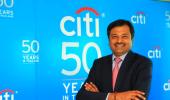In India, it is not easy to fight it out with the large banks which are nimble-footed and technology-savvy and are continuously innovating on the retail turf with newer products for customer acquisition.

Citibank NA, the largest foreign bank in India by assets and profits, may close down its consumer banking division.
A Bloomberg report on February 20 says the company is weighing divesting some units in retail banking in the Asia-Pacific region, including those in South Korea, Thailand, the Philippines, and Australia, quoting people familiar with the matter.
Though it did not mention India, overseas sources told Business Standard the Indian consumer banking business of the US bank was under scrutiny and could be hived off in coming months.
Reorganising Citigroup Inc’s international consumer operations is on the table of its new chief executive officer (CEO) Jane Fraser, who took charge on March 1.
In an email response to Business Standard’s query over the weekend, Debasis Ghosh, public affairs officer, Citi India cluster, said: “As our incoming CEO Jane Fraser said in January, we are undertaking a dispassionate and thorough review of our strategy, including our mix of businesses and how they fit together.
"As you would expect, many different options are being considered and we will take the right amount of time before making any decisions.”
On a conference call with analysts in January, Fraser said: “We’re taking a clinical look at our strategic positioning, assessing which businesses can attain leading market positions in a much more digitalised world.… I believe there is value to unlock by simplifying the firm.”
It is not clear yet if the cards business would also be sold as part of the consumer finance portfolio, or the bank would keep it.
According to sources, the bank is in no hurry and can try all combinations to maximise value.
If it makes sense to keep the cards business, that can be considered, sources said.
Since this is not a distress sale, there will be many takers for Citi’s consumer banking portfolio with the right price, particularly if the credit business becomes a bolt-on sale, says a banking sector analyst in India.
Fraser, the first woman CEO of a major Wall Street bank and is taking the reins from Michael Corbat, headed Citi’s consumer business in her last assignment.
As head of the Latin American business in her previous assignment, she had sold Citi’s retail-banking and credit-card operations in Brazil, Argentina, and Colombia.
Anand Selvakesari, who took over as CEO of global consumer banking, was instrumental in strengthening Citi’s credit card business in India a decade ago as head of consumer banking in India, while Muge Yuzuak was overseeing the card business.
In 2012, with a 21 per cent market share, Citibank was the No. 2 credit card issuer in India, while expenditure per card was double the industry average; it also had a 30 per cent share in e-commerce spend.
By 2020, its market share slipped to around 6 per cent and the position to sixth even though average card spend remained 1.4x higher than the industry mean.
In August 2020, Citibank in India served 2.9 million retail customers with 1.2 million bank accounts and 2.2 million credit card accounts.
The 119-year-old bank has 35 branches and employs over 19,000 people.
The bulk of the employees are part of Citicorp Services India, an outsourcing centre that caters to different geographies of the US bank.
Under the bank’s umbrella, there is also Citicorp Finance (India), a non-banking financial company (NBFC), and Citigroup Global Markets India is its investment banking arm.
Back in 2013-14, the bank merged its retail-focused arm Citi Financial Consumer Finance with itself, and floated Citicorp Finance focused on commercial loans.
The retail NBFC was crumbling under a pile of bad assets, and its losses were mounting.
With over 400 branches in India and 2,000 employees, the NBFC was in the business of mortgages, personal loans, and investment products.
In March 2020, Citi had Rs 2.19 trillion assets on its balance sheet and made a net profit of Rs 4,918 crore.
Its gross bad loans were 1.43 per cent of the loan book and, after provisioning, net bad loans were 0.56 per cent.
Its closest peer, Hongkong and Shanghai Banking Corporation (HSBC) India, posted a net profit of Rs 2,778 crore on an asset book of Rs 2.11 trillion.
The bank’s bad loans were lower than those of Citi.
The third-largest foreign bank in India, Standard Chartered Bank (StanChart), made a Rs 2,834 crore profit on a Rs 1.84-trillion asset base, even as its bad loans were far higher than other two — 6.35 per cent gross bad loans and 0.8 per cent net bad loans.
Over a period, the contribution of the corporate loan book to the profits of Citibank has been growing, while the retail business’ return is falling.
The returns on corporate assets, according to sources, are double those of retail assets, consisting of mortgages, auto loans, personal loans, wealth management, and broking.
After the winding down of Citi Financial Consumer, Citibank’s consumer business staged a turnaround and started doing well, but the pace of growth has been slowing in the absence of investment to keep up with local rivals.
It is not a loss-making business, but its share of overall profit has come down from around 25 per cent to 10 per cent in the past few years, with gross profit margins shrinking.
The share of retail banking in revenue is shrinking.
Retail banking contributed to 30.6 per cent to revenue at the end of March 2020, against 37.38 per cent in 2012-13 and nearly 39.19 per cent in 2009-10.
Ten years ago, India had been among the first 15 markets for the US bank; by the last decade, it rose in ranking among the top four markets, largely on the strength of corporate banking.
The Comptroller of the Currency in the US and the US Federal Reserve have criticised Citibank for shortcomings in its technology.
Citibank closing down its consumer banking division will strengthen the growing belief in the analyst community that global banks have a limited role to play in retail markets outside home countries unless they spend handsomely on technology and innovation.
In India, it is not easy to fight it out with the likes of HDFC Bank, ICICI Bank, Axis Bank, Kotak Mahindra Bank and large public sector banks such as State Bank of India and Bank of Baroda which are nimble-footed and technology-savvy and are continuously innovating on the retail turf with newer products for customer acquisition.
Over the past few years, StanChart has sold its asset management company and closed down its institutional cash equities, equity research, and equity capital markets; JPMorgan has surrendered its NBFC licence; BNP Paribas has shut down its wealth management business; Deutsche Bank has sold its credit card business to IndusInd Bank; and HSBC has closed down its private banking business and some of its branches.
British bank Barclays Bank and South African FirstRand Bank have buried their retail dream on Indian soil.
On the hand, the Indian subsidiary of DBS of Singapore is in the process of acquiring Lakshmi Vilas Bank.
In November 2020, affirming Citi India’s short-term issuer rating at ‘IND A1+’, India Ratings and Research said the ratings continued to reflect Citibank NA’s financial strength, and the agency’s expectations of continued strong support from the latter, if required.
Citi India is a branch and its liabilities are those of Citibank.
Even as it continues as a marquee foreign bank in India, consumers will look at Citi in a different light once it becomes a pure-play corporate bank.
In the 1990s, when it was ruling the roost in the nascent credit market, Citi never slept.
Early this century, Citi took the call to go to the suburbs.
After selling its consumer business, it will return to the city.
Photograph: Mike Segar/Reuters












 © 2025
© 2025